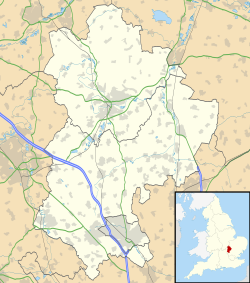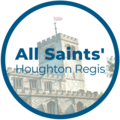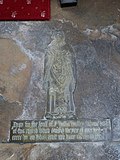| Date | Parish Priest | Patron | Notes |
|---|
| 1 | 1226 | Stephen de Herdewicke | Abbot & Convent of St Albans | |
| 2 | 1241 | Roger | Abbot & Convent of St Albans | on resignation of Stephen de Herdewicke |
| 3 | 1265, 27 October | Walter de Cameseya | Abbot & Convent of St Albans | on death of Roger |
| 4 | | John de Dunstaple (Dunstable) | Abbot & Convent of St Albans | |
| 5 | 1272, 3 May | William de Labho | Michael Picot and Johan his wife by licence from King Edward I | on death of John de Dunstaple |
| 6 | 1283 | Walter de Kemesey | Abbot & Convent of St Albans | |
| 7 | 1291, 16 June | Simon de Wendover | Abbot & Convent of St Albans | |
| 8 | | Adam de Sewell | Abbot & Convent of St Albans | |
| 9 | 1336, 23 March | William de Eyton | Abbot & Convent of St Albans | on resignation of Adam de Sewell |
| 10 | 1337, 27 June | Robert de Morton | Abbot & Convent of St Albans | on resignation of William de Eyton |
| 11 | | John Walleys | Abbot & Convent of St Albans | Buried in the chancel alongside William Walley (a relative of his). Commemorative brass also in the chancel. |
| 12 | 1412, 18 April | John Buneker | Abbot & Convent of St Albans | on death of John Waleys |
| 13 | 1448, 27 July | Thomas Copto (or Copton) | Abbot & Convent of St Albans | on death of John Buneker |
| 14 | 1458, 18 June | Robert Russelle | Abbot & Convent of St Albans | on resignation of Thomas Copto, from Rectory of Hardwardstoke, Diocese of London |
| 15 | 1459, 2 March | Robert Tomlynson | Abbot & Convent of St Albans | on death of Robert Russelle |
| 16 | 1481, 6 November | Thomas Standyssh, MA | Abbot & Convent of St Albans | on death of Robert Tomlynson |
| 17 | 1493, 20 October | William Walley | Abbot & Convent of St Albans | on death of Thomas Standyssh; Buried in the chancel along with John Walley (a relative of his). Commemorative brass also in the chancel. |
| 18 | 1506, 21 June | Thomas Rither, BA | Abbot & Convent of St Albans | on death of William Walley |
| 19 | 1526 and 1534 | William Fossey | Abbot & Convent of St Albans | recorded as vicar at two dates; registered as brother of Guild of Holy Trinity, Luton |
| 20 | 1554, 14 November | John Cowper | John Tymse, yeoman | on death of last vicar The advowson is passed to Tymse from the "Abbot and Convent of Monastery of St Albans". |
| 21 | 1557, 14 November | Maurice Penyall | Queen Mary I and King Philip II of Spain | on death of John Cowper. This entry is missing from the list preserved at All Saints' Parish Church. Penyall is recorded also in the list of vicars of Caddington, 14 March 1561. The advowson rests now with the Monarch. |
| 22 | 1563, 24 March | George Johnson | Queen Elizabeth I | presented on petition of Mr Brocket |
| 23 | 1567, 29 August | George Mydelton | Queen Elizabeth I | presented on petition of Bishop Nicholas Bullingham, Bishop of Lincoln |
| 24 | 1588, 4 May | John Fabian, MA | Queen Elizabeth I | on death of George Mydelton |
| 25 | 1588, 14 November | Thomas Butler | Queen Elizabeth I | on death of John Fabian |
| 26 | 1588, 11 December | Roger Rogers | Queen Elizabeth I | on death of Thomas Butler, instituted 17 December 1588 |
| 27 | 1607, 23 June | Thomas Tompkins, MA | Lord Keeper of Great Seal - Thomas Egerton, 1st Viscount Brackley | on recommendation of Sir Richard Spencer; married Phoebe Eames on 1 Aug 1607 |
| 28 | 1659, 27 April | Richard Scott | Henry Brandreth of London, merchant | Brandreth acquires the advowson from John Egerton, 1st Earl of Bridgewater in 1653 |
| 29 | | John Littlejohn | Henry Brandreth of London | ordained priest by Thomas Morton, Bishop of Durham, 23 October 1658. Littlejohn is recorded at Salford (Bedfordshire) in 1690. [15] |
| 30 | 1660, 18 September | Andrew Cater | Henry Brandreth of London | on resignation of Littlejohn |
| 31 | 1661, 17 August | James Paddon | Henry Brandreth of London | buried 25 Apr 1704 |
| 32 | 1704, 26 September | Valentine Cressy, BA | Nehemiah Brandreth | on death of James Paddon; buried 27 Aug 1728 |
| 33 | 1728, 16 September | Jacobus Bradshaw | Henry Brandreth (2nd) | on death of Valentine Cressey; buried 24 Dec 1738 |
| 34 | 1739, 9 May | John Wilkinson, STB | | on death of James Bradshaw; also vicar of Flitwick Around 1750 Henry Brandreth (3rd) (great-grandson of the Henry "of London") sells the estate to the Duke of Bedford. [16] The advowson is passed to the Duke. |
| 35 | 1759, 31 May | Potts Davies, BA | John Russell, 4th Duke of Bedford | on death of John Wilkinson |
| 36 | 1768, 13 May | Edmund Wodley, BA | John Russell, 4th Duke of Bedford | |
| 37 | 1808, 20 August | Thomas Cave, MA | John Russell, 6th Duke of Bedford | |
| 38 | 1819, 18 February | John Donne | John Russell, 6th Duke of Bedford | on death of Thomas Cave. Donne is buried at the east end of All Saints' churchyard. |
| 39 | 1846, 1 September | William Wilson | Francis Russell, 7th Duke of Bedford | on death of John Donne |
| 40 | 1856, 16 January | Hugh Blagg Smyth, MA | Francis Russell, 7th Duke of Bedford | |
| 41 | 1880 | Daniel Pring Alford, MA | Henry Chernocke Gibbs Brandreth | Manor lands of Houghton Regis are reacquired by the Brandreth family, along with the advowson. [16] |
| 42 | 1883 | William Faux Lovell, MA | Henry Chernocke Gibbs Brandreth | |
| 43 | 1899, March | William Wedge, BA | Henry Chernocke Gibbs Brandreth | |
| 44 | 1912, July | Frederick Charles Mahony, MA | Evelyn Lawton, widow of H.C. Gibbs Brandreth | |
| 45 | 1928, February | Charles Henry Fletcher | S.L. Elbourne | |
| 46 | 1952, July | Leslie Blackburn, BA | Prebendary W. F. Buttle | |
| 47 | 1975 | Geoffrey Martin Neal, AKC | Diocesan Board of Patronage (Diocese of St Albans) | |
| 48 | 1996 | Jonathan Francis Redvers-Harris, LLM | Diocesan Board of Patronage (Diocese of St Albans) | on resignation of Geoffrey Neal |
| 49 | 2003 | Brian Clifford Wheelhouse SSC, BTh | Diocesan Board of Patronage (Diocese of St Albans) | on resignation of Jonathan Redvers-Harris |
| 50 | 2015, 1 June | Diego Galanzino, MA | Diocesan Board of Patronage (Diocese of St Albans) | Priest-in-charge, on resignation of Brian Wheelhouse |








